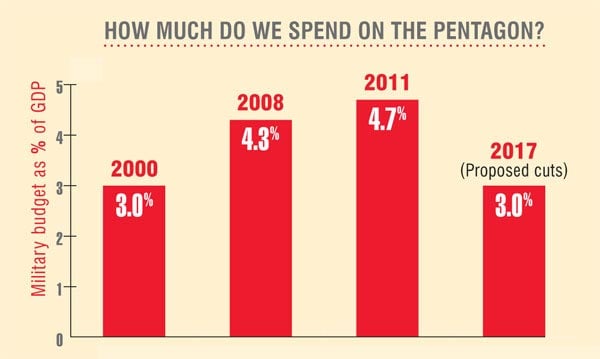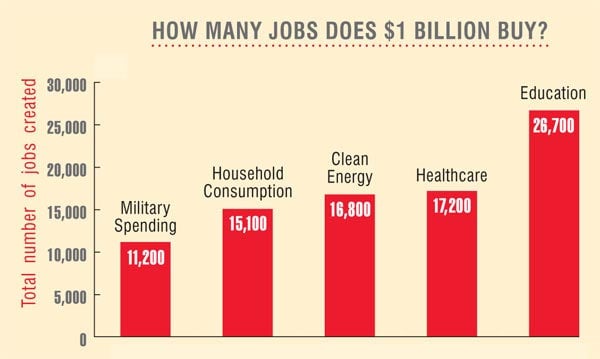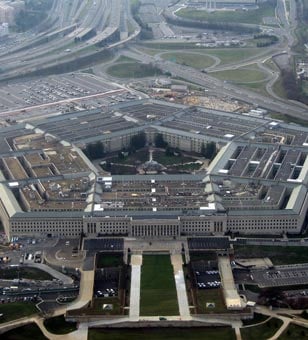Do you support Truthout’s reporting and analysis? Click here to help fund it.
Should the enormous US military budget—which is more than double the combined levels of military spending by China, the United Kingdom, France, Russia and Germany—be cut? This question is finally on the table, thanks to the winding down of combat activities in Iraq and Afghanistan and to Washington’s obsession with tamping down the federal deficits that have arisen from the Great Recession. Many who would like to protect the military from the budget knife raise economic arguments to make their case: Won’t cutting military spending be bad for jobs, just when we need to maintain focus on reducing unemployment? Won’t it threaten the country’s long-term technological capabilities?
The matter assumed increased urgency in November after the Congressional supercommittee failed to agree on a deficit-reduction plan. This failure set in motion an agenda for automatic cuts—or “sequestration” of funds—from military and nonmilitary budgets beginning in January 2013. According to the sequestration scenario, absent the adoption of a large-scale deficit-cutting plan, military and nonmilitary spending would face $55 billion per year in automatic cuts over a decade, relative to previously established spending levels. If Congress and the White House devise a way to exempt the Pentagon from the automatic cuts—as seems increasingly likely—the cuts will instead be taken from healthcare, education, social spending, infrastructure and the environment.
Of course, framing the deficit issue in terms of military versus social spending cuts ignores other options, such as raising taxes on the wealthy. It also erroneously assumes that reducing the federal deficit is necessary now, before the economy has settled onto a sustainable recovery path out of the recession. Even more fundamental, today’s debate largely skirts the question of what the military budget needs to be after Iraq and Afghanistan, and fails to grapple honestly with the impact that major military spending reductions would have on the economy, especially in terms of job opportunities and technology.
Members of today’s military-industrial complex—the constellation of forces, including Democratic and Republican politicians, weapons manufacturers, lobbyists and the Pentagon leadership, whose influence President Eisenhower warned against in 1961—claim that significant reductions in the military budget would decimate US defenses and inflict major damage to the economy. In fact, these claims are demonstrably false.
The Proposed Spending Cuts Are Modest
Defense Secretary Leon Panetta has stated that the planned cuts in the military budget would result, over a decade, in “the smallest ground force since 1940, the smallest number of ships since 1915 and the smallest Air Force in its history.” Panetta has said repeatedly that the cuts would amount to nearly $1 trillion. That does indeed sound like a lot, given that the annual level of total military spending is about $700 billion.
But what Panetta and others call $1 trillion in cuts is actually an annual $100 billion reduction added up over ten years to produce the huge-sounding $1 trillion figure. In reality, moving from a roughly $700 billion to $600 billion annual budget is hardly extreme, especially when we consider that this includes cuts tied to ending the US combat role in Iraq and Afghanistan. The 2012 budget for these two wars alone is $115 billion, and the planned budget for 2013 is $88 billion, even after combat is over. The Pentagon has also included for 2014 onward a baseline contingency budget of $44 billion annually for any carryover fighting in Iraq or Afghanistan, or new wars elsewhere. Thus, by the Pentagon’s own estimate, winding down Iraq and Afghanistan will end up saving $44 billion a year after 2013. In the unlikely event that the budgetary sequestration cuts are carried out, an additional $55 billion per year would be cut. That’s how we cut our way from a $700 billion to $600 billion annual military budget.
The graph below provides some perspective on these figures. As we see, last year’s $700 billion military budget represented 4.7 percent of the country’s GDP. This was higher even than in 2008, Bush’s last year in office, when defense was 4.3 percent of GDP. In 2000, Bill Clinton’s final year in office and before the 9/11 terrorist attacks, military spending was 3 percent of GDP. In today’s economy, the difference between a military budget at 3 percent of GDP versus 4.7 percent is $260 billion. Thus, if we were to return just to the 2000 level of defense spending as a share of the economy, that would itself entail “budget cuts” of about $1 trillion over four years (i.e., $260 billion per year for four years).

If all the cuts being discussed today were enacted—including the $55 billion in sequestration cuts, which, again, seems highly unlikely—the military budget would return to about 3 percent of GDP in 2017, according to the Defense Department’s budget forecast as well as the Congressional Budget Office’s projections. This is assuming—perhaps implausibly—that the United States does not engage in new wars between now and 2017. If we do end up fighting more wars, the budgets to pay for them would be exempt from spending caps. The sky would be the limit. In short, aside from winding down the Iraq and Afghanistan wars, the military cuts being considered are modest and easily reversible.
Better Ways to Create Jobs
The primary economic argument made by members of the military-industrial complex against cutting the Pentagon budget is that it would produce major job losses. One widely cited report by Stephen Fuller of George Mason University found that 1 million jobs would be lost through the annual cuts set by the sequestration agreement. The Pentagon claims that military cuts in the range of $1 trillion over the next decade would raise unemployment by one percentage point per year—from, say, 8 to 9 percent. It is hard to assess the accuracy of either of these claims, since neither Professor Fuller nor the Pentagon has provided details about how these estimates were reached.
In any event, it is indisputable that the Pentagon is a major employer in the US economy. How could it be otherwise, given that the Pentagon’s $700 billion budget is equal to nearly 5 percent of the GDP? In fact, Pentagon spending as of 2011 was responsible for creating nearly 6 million jobs, within the military itself and in all civilian industries connected to it. In addition, because of the high demand for technologically advanced equipment by the military, a good share of the jobs created are well paid and professionally challenging.
However, the crucial question is not how many jobs are created by spending, for example, $1 billion on the military. Rather, it is whether spending that $1 billion creates more or fewer jobs when compared with spending $1 billion on alternative public purposes, such as education, healthcare and the green economy—or having consumers spend that same amount of money in any way they choose.
In fact, compared with these alternative uses, spending on the military is a poor source of job creation. As we see in the graph below, $1 billion in spending on the military will generate about 11,200 jobs within the US economy. That same $1 billion would create 16,800 jobs through clean energy investments, 17,200 jobs within the healthcare sector or 26,700 jobs through support of education. That is, investments in clean energy, healthcare and education will produce between 50 and 140 percent more jobs than if the same money were spent by the Pentagon. Just giving the money to households to consume as they choose would generate 15,100 jobs, 35 percent more than military spending.

To make these estimates, we considered three distinct channels through which spending on any project creates jobs. First are the jobs directly involved with the project in question—for example, building an F-35 fighter jet, or undertaking an energy-efficiency retrofit of the government’s existing building stock. In addition, new jobs result when the F-35 or building retrofit project buys supplies. The supplying industries would include steel, glass, tire and electronic producers for building an airplane; and, for the retrofit project, firms that produce windows, insulation, and heating and cooling equipment. Finally, job opportunities will expand when the people newly hired for the F-35 or retrofit project start spending more money, since they now have more in their pockets. This could include a newly hired computer programmer on the F-35 project finally feeling financially able to replace a clunker car, or a window installer on the retrofitting project taking a previously unplanned vacation.
But why do we get so many more jobs per dollar of spending through investments in healthcare, clean energy and education than through the military? The reasons are straightforward:
Spending on people versus everything else. Retrofitting buildings entails hiring lots of electricians, carpenters and roofers, with a relatively modest level of spending on machinery, energy, land and heavy-equipment hauling. Building the F-35, by contrast, entails heavy investments in electronic equipment and carefully treated steel, glass and other materials, with less need to hire people.
Spending within the US economy versus other countries. Even with the ending of direct involvement in Iraq and Afghanistan, the overall amount of overseas spending by the US military and its personnel will remain far higher than when funds are spent on domestic investments in healthcare, clean energy and education. When a higher proportion of a given pot of money is spent within the country, more jobs are provided for US workers.
Differences in pay scales. Average pay for all the jobs connected with military spending—including directly employed personnel and those working for military suppliers—is about $60,000 per year. By contrast, with healthcare, clean energy and education, the average annual pay is closer to $50,000, or 20 percent less. If there is a given pot of money available for hiring workers, when you pay each person a higher wage, that will create fewer—if better compensated—jobs.
Does this mean military spending creates more good jobs? Actually, no. Because spending on clean energy, healthcare and education creates so many more jobs overall—as much as 50 to 140 percent more—these investments also create larger numbers (if lower proportions) of decent- to good-quality jobs than the military, as well as many more low-paying jobs.
Considering only jobs paying at least $32,000 per year, clean energy and healthcare both generate well more than the military, while the figure for education spending is more than twice as high. Considering a still narrower category of jobs—only those paying $64,000 or more per year—the totals for clean energy and healthcare are roughly comparable to the military’s, while the figure for education is double that for military spending.
We should also not dismiss the jobs paying below $32,000, in which the totals for clean energy, healthcare and education are all at least twice that for the military. It is certainly better to have more low-paying jobs available than no jobs at all. Low-paying jobs can be improved through union organizing, job training and a reasonable minimum wage, which should be $12 per hour today. Also, prospects for organizing to improve these jobs will rise when there are more low-paying jobs available. It is much harder to fight for improving job quality when the jobs are not there in the first place.
We Need New Industrial Policies
This past January a New York Times article presented the view that the most serious negative economic consequence of the impending military budget cuts would not be on job opportunities but rather on the economy’s capacity to sustain a successful high-technology growth path. The Pentagon’s achievements in nurturing the Internet, jet aviation and other transformational technologies from inception to commercial success are indeed significant. However, given the massive resources the military has devoted to technology development, should we expect anything less? Since the end of World War II, the Pentagon has spent more money on R&D than any other entity on the face of the earth. For 2011 the Pentagon’s R&D budget was about $81 billion. This was more than half of federal spending on R&D and fully 20 percent of all R&D spending—public and private—in the economy. Moreover, the Pentagon’s share of total US R&D spending had been significantly higher still during the cold war era.
Yet even these R&D spending figures understate the scope of the Pentagon’s investments in technology development. This is because the key factor in the success of the program has not been R&D spending by itself. Equally important has been the way the Pentagon’s procurement policies create and sustain huge guaranteed markets for the products emerging from its R&D programs.
This is the main theme of the late Vernon Ruttan’s book Is War Necessary for Economic Growth? Ruttan’s answer to that question is that war is not necessary for economic growth but that industrial policies based within the Pentagon have been a primary, irreplaceable force for advancing US technical progress. Ruttan saw this combination—huge amounts of direct R&D spending along with maintaining guaranteed markets for the high-tech products being developed—as the foundation undergirding the Pentagon’s successful industrial policies. This is what enabled emerging technologies such as the Internet to incubate slowly over time rather than have to prove their value prematurely to private businesses and consumers. The incubation period for the Internet was about thirty-five years. The R&D work around such projects could therefore remain focused on developing high-quality products rather than on achieving big-profit payoffs as quickly as possible. By contrast, no private business firm operating on its own could possibly survive long-term without being laser-focused on profitability.
But in recognizing the Pentagon’s achievements in industrial policy, we also need to acknowledge its outsized failures. The Pentagon has a long record of handing out noncompetitive, gold-plated, cost-plus contracts to its favored weapons suppliers such as Lockheed Martin and General Dynamics. The Defense Department itself reported in 2010 that nearly one-fourth of all service contracts put out to competitive bidding had only one bidder. Under such cozy arrangements, it is not surprising that cost overruns on military procurement projects—the difference between what procurement was contracted to cost and what it actually did cost—reached around $70 billion over 2009–10. This figure is roughly equal to the State Department’s entire foreign affairs budget for that period.
Such cost overrun figures do not recognize the still more fundamental matter that continuing to maintain the gigantic military-industrial complex is not the most effective means of advancing national security. As Miriam Pemberton and Lawrence Korb write in their study “A Unified Security Budget for the United States,” “The death of Osama bin Laden was accomplished by means that resembled a police action…. The decade of war the United States launched in response to the 9/11 attacks, at the cost of a trillion-plus dollars and many thousands of lives, has failed to accomplish a goal that was finally achieved at a tiny fraction of these costs, through a coordinated action of investigative work, diplomacy, and minimal military force.”
What are the lessons here? The United States certainly needs to continue advancing large-scale industrial policies to promote the development of cutting-edge technologies. But the most pressing areas for technological development are not in ever more dazzling weapon systems but in clean energy, mass transportation and high-end manufacturing. Given these priorities, there is no reason that such industrial policies should continue to be controlled by the Defense Department. Indeed, as Ruttan concluded—and as Seymour Melman has also demonstrated in Pentagon Capitalism, The Permanent War Economy and other works—having industrial and technology policy dominated by the Pentagon has imposed heavy costs on the economy. As one example, research that would lead to the production of cheap solar energy has languished for a generation, with no significant public support and certainly nothing like the guaranteed markets the Pentagon provides for weapons producers.
The broader lesson is also clear. If we are going to advance beyond the past decade of war and the wreckage caused by the Great Recession to build a stable, secure and environmentally sustainable society, we need to break the grip of the military-industrial complex on the $700 billion military budget. That is, we need to take seriously President Eisenhower’s warnings about the “disastrous rise of misplaced power” wielded by this nexus of forces. To advance its aims, the military-industrial complex is creating a seriously distorted picture of the effect of military spending cuts on national security and the economy. The way to fight back begins with the simple task of presenting the facts—and advancing policies for a widely shared economic revival grounded in these facts.
Join us in defending the truth before it’s too late
The future of independent journalism is uncertain, and the consequences of losing it are too grave to ignore. To ensure Truthout remains safe, strong, and free, we need to raise $48,000 in the next 8 days. Every dollar raised goes directly toward the costs of producing news you can trust.
Please give what you can — because by supporting us with a tax-deductible donation, you’re not just preserving a source of news, you’re helping to safeguard what’s left of our democracy.
